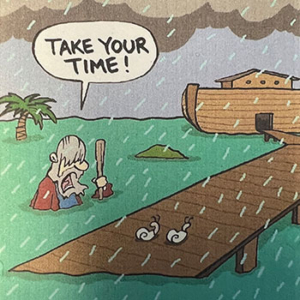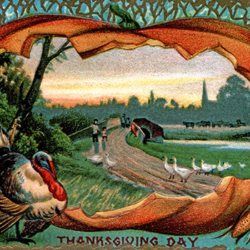 Can you remember the old Arte Johnson bit from the TV skit show Laugh-In?
Can you remember the old Arte Johnson bit from the TV skit show Laugh-In?
“Today — I haff good news — und I haff bad news.” My column this month is a bit like that but without the German uniform and smoldering cigarette. I’ll start with a standard old person’s lament: I can’t believe January is already relegated to the past. How can a month go by so quickly? Can you remember measuring time during grade school? Our grading periods were six weeks long. This timeline was important to students because, at the end of each six-week period, there would be a “Teacher’s Work Day,” presumably for them to bring current all the grades from the previous weeks and generate a final grade for the report card. While most students weren’t excited about the report card, everyone I knew loved the ‘extra’ student holidays. Looking back, however, the only thing I can remember about those days off is not what I did with the time, but rather that they took seemingly forever to come ‘round.
 Waiting for the end of a bear market is a bit like that for most of us, I imagine – trudging to and from school four miles a day each way through waist-deep snow (in Florida, no less) and uphill both ways.
Waiting for the end of a bear market is a bit like that for most of us, I imagine – trudging to and from school four miles a day each way through waist-deep snow (in Florida, no less) and uphill both ways.
Since I wanted to give you a real perspective on time today, I did a little internet research to get a handle on the average length of bear markets. This research gave me all sorts of contradictory information easily disproved by anyone with a calculator and a little access to history. So much for the internet and ready access to the total accumulation of mankind’s knowledge since the apes found the monolith in 2001: A Space Odyssey (That was a documentary, wasn’t it? Further off-topic – Stanley Kubrick was a brilliant nut.)
Back to the matter at hand: after much rigorous effort, I came up with my best guestimates of some average numbers for you: The average bear market comes along every 4.5 years and lasts about 13 months. This information is, of course, only useful to statisticians and those contemplating the past, and it is completely useless for predicting what will happen in the markets tomorrow. This data, however, is fine for our purposes. I’ll get to that in a minute.
IF (notice the if – it suggests a premise we must accept for the conclusion to be valid), if we can accept that past 100 years of market returns give us some indication of what to expect in the future, and nothing fundamental has changed for the negative in the way America conducts business, then we can have some degree of confidence what to expect in returns over the long term.
It is most easily seen in graph form, I think. Ask me for a copy of the Ibbotson chart when you next come in for a visit. You’ll love it. Okay, maybe not, but it is interesting.
 And this, dear reader, is why I spend so much time when we talk, asking how much you spend each month, what big expenditures you foresee in the next several years, and how much cash savings you have tucked away in the bank or, heaven forbid, in the mayonnaise jar.
And this, dear reader, is why I spend so much time when we talk, asking how much you spend each month, what big expenditures you foresee in the next several years, and how much cash savings you have tucked away in the bank or, heaven forbid, in the mayonnaise jar.
Planning with confidence that bear markets will come, and we have prepared for them, will get us through dark market days that may drag on like Calvin experiences on a school day while Hobbes sits home alone watching the clock.
But I know you. You are still looking for numbers. Okay then, here you are: Most of the pundits I read say that if we connect the market points on January 1 and December 31 of this year, it will be a flat line with an underlying irregular saw-tooth pattern throughout the year.
‘Everyone’ predicts some sort of recession this year, but my friend Dan from Franklin Templeton likes to remind me, “Whenever everyone agrees on what is going to happen in the economy or stock market, you can be sure they are all wrong.” Ha, a truism there which is applicable to many of life’s circumstances, don’t you think?
So recession? Maybe. Deep?
Doesn’t appear so at this time.
Markets? I’m not overly optimistic, but I am staying invested.
Why? I would like you to look at two numbers on your statements if you have them. The September 30, 2022, account value was about the low for the year. Then look at the January 31st statement from this year. Most of us have seen a nice little recovery, haven’t we?
It has not received a lot of attention, and any market enthusiasm was dampened during the first half of October and all of December, but if you look at the period from the end of September to the end of January, the S&P 500 is up about 13% during that time.
And this is why I encourage both you and me to stay invested for the long haul.
As I have said and wish to emphasize again, I don’t know if the market will take back that 13% rise I just spoke about or even take more over the coming months, but I do believe that at some point, the markets will begin to rise, continue to fluctuate as they do, and eventually set a new all-time high. I do not want you to miss either that first quiet upturn waiting for “better times” or the new highs whenever they might come. That’s why I so often preach, “stay the course.”
But don’t do it alone. As always, let’s keep talking!
And since I was all dry and market-nerdy this month, here is a bit of wisdom and philosophy I came across recently. I liked it enough to share it with you.
There are certain kinds of currency you acquire in life. Most of it is ephemeral. But friendship and faith in the unseen world and the commitment to be true unto thine own self are the human glue that you never give up, not for any reason.
– James Lee Burke
February 2023
The opinions voiced in this material are for general information only and are not intended to provide specific advice or recommendations for any individual. All performance referenced is historical and is no guarantee of future results. All indices are unmanaged and may not be invested into directly.

 Waiting for the end of a bear market is a bit like that for most of us, I imagine – trudging to and from school four miles a day each way through waist-deep snow (in Florida, no less) and uphill both ways.
Waiting for the end of a bear market is a bit like that for most of us, I imagine – trudging to and from school four miles a day each way through waist-deep snow (in Florida, no less) and uphill both ways. And this, dear reader, is why I spend so much time when we talk, asking how much you spend each month, what big expenditures you foresee in the next several years, and how much cash savings you have tucked away in the bank or, heaven forbid, in the mayonnaise jar.
And this, dear reader, is why I spend so much time when we talk, asking how much you spend each month, what big expenditures you foresee in the next several years, and how much cash savings you have tucked away in the bank or, heaven forbid, in the mayonnaise jar.


